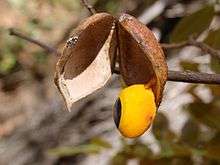Copaifera langsdorffii
| tree | |
|---|---|
| | |
| Copaifera langsdorfii in a park in São Paulo Brazil. | |
| Scientific classification | |
| Kingdom: | Plantae |
| (unranked): | Angiosperms |
| (unranked): | Eudicots |
| (unranked): | Rosids |
| Order: | Fabales |
| Family: | Fabaceae |
| Genus: | Copaifera |
| Species: | C. langsdorffii |
| Binomial name | |
| Copaifera langsdorffii Desf. | |

The tropical rainforest tree Copaifera langsdorffii is known as the Diesel Tree,[1] Rashed Tree and Salam tree. It has many names in local languages, including kupa'y, cabismo, and copaúva.
Biological description
It is a medium-sized tree usually reaching 12 meters in height, with white flowers and small, oily fruits. The wood is light due to its porosity, and it is honeycombed with capillaries filled with oil. Tapping the tree involves cutting a well into which the oil seeps and where it can be easily collected. Despite its vigorous production of oil, the tree does not grow well outside of the tropics. It has potential to be a reliable source of biodiesel in tropical climates but the tree does not thrive in colder or more temperate climates.
Uses
Biodiesel use
The diesel tree can be tapped every six months for 20+ litres of fuel, and it will continue producing for around 70 years. One acre with around 100 mature (15-20+ years old) trees would produce up to 25 barrels of diesel per year which could sustain the fuel needs of small farms (40 litres per tree per year). With one gallon of diesel typically taking around 7 barrels of crude oil to produce, natural diesel could also become a cash crop for South American farmers.[2]
Wood uses
The wood can be burned for firewood or used in carpentry.
Pollen collector
Bees utilize the tree for pollen collection.
Medicinal uses
The plant has a great number of historical medicinal uses.